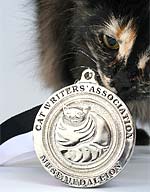 |
|||||||||||||||||||
|
|

We are the proud winners of the 2006 - 2009 winner of the Muse Medallion for Online Magazine by The Cat Writers? Association in their annual Communications Contest! (Photo courtesy of Weems Hutto).
On November 17, 2007 Felinexpress.com was honored to receive The President's Award by the Cat Writers' Association. We are very proud to have earned this distinction and will continue to provide quality information for all cat lovers.
Felinexpress.com Home > Cat Health > Cats and Hairballs |
Cats and Hairballs
The first time a cat licked you, you may recall the cat’s tongue felt similar to sandpaper running over your skin. One of the cat’s most efficient tools; the tongue serves as a taste tester, a grooming comb and a straw for liquids. If you look at a cat’s tongue, you will see in the middle of the tongue, rows of pointed spines pointing to the rear of the cat’s mouth. These spiny-like objects are known as papillae. When a cat is eating his prey, these papillae serve as grippers so the prey won’t escape. Unfortunately these papillae also serve as a grabber of hair and other soft material. If a cat is pulling on a mat on his fur, the hair will stick to these points. Kitty has no recourse except to swallow the hair. This is where both short-hair and long-haired kitties get into problems; they get hairballs. In some cats, hairballs cause digestive upset. They will vomit up the offending item. In severe cases, hairballs can cause internal impactions requiring emergency surgery.
Cats: so limber and flexible they are able to reach almost all areas of their body while grooming. On hot days, they will be busy grooming themselves and other cats as the saliva keeps them cool. (Cats sweat from the pads of their feet). In colder weather, they keep warm by grooming. When they lick their fur they are insulating their hair against the cold air.
To keep kitty comfortable and free of hairballs, daily grooming with a brush is highly recommended. You may notice when you pet a cat, immediately after you are done petting him, he sets about licking his fur. trying to remove your scent replacing it with his own. Grooming your cat instead of petting him, you will cut down his grooming time for you are redistributing his scent from the brush back to his body. The longer he licks himself to get the familiar scent back, the better the odds of him getting a hairball.
What is a hairball?
A hairball is the accumulation of wadded up loose cat hair, cat saliva and stomach juices. You can find hairballs on your carpet (or in my case inside my favorite slippers) They are shaped like tubular objects and are fairly disgusting to find as I am sure it is equally unpleasant for your cat to vomit them up. Because they come back up through the esophagus and its narrow opening this results in the tubular appearance of a hairball. My husband calls them “hairy caterpillars!” If the hair passes further through the intestinal tract, hairballs can be found in cat poop.
How do I know if my cat has hairballs?
You may notice your cat bent low to the ground, neck stretched forward making retching or coughing sounds. Soon he presents you with a hairball all your own.
Hairballs can cause:
- Lack of appetite
- Lethargic behavior
- Constipation
- Diarrhea
How can I control hairballs?
- The best way to control hairballs is to make it a ritual to brush your cat every day. If you have a kitten, start out early with something less invasive such as the Zoom Groom or a soft baby brush.
- Currently there are several dry foods on the market that control hairballs. Commercial-based hairball remedies are also available. The most popular being Laxatone, a petroleum-based product you put on your cat’s paw or directly into his mouth. Laxatone is sticky. In an attempt to get rid of the sticky mass on his paw, you may end up wearing most of it if the cat shakes his paw violently.
- You can also give your kitty ½ teaspoon of the pure white petroleum jelly- (I add tuna juice to it to make it a bit more palatable for kitty). Use this method only once or twice a week. Some pet food companies also provide cat treats that control hairballs.
- If you have mineral oil on hand, add a bit to the wet food for the cat who is suffering from hairballs.
- Fish oil capsules will have the same effect- just break open two capsules and pour the oil over the dry food.
If untreated, hairballs can lead to chronic gastritis and other stomach upsets. If your cat is prone to matting use a heavy-duty seam ripper to remove the mats first, then afterward, bond with your cat by brushing the loose hair out with a gentle brush or comb.
More cat breeds |
|
? Copyright 2006-2010 Felinexpress.com, All Rights Reserved
Privacy Statement - Disclaimer - About Me


